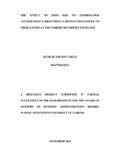| dc.description.abstract | Information asymmetry is a situation in which one party in a transaction has more or
superior information compared to another. That is, information is held by one, but not
all of the parties to a transaction. This could be a harmful situation because one party
can take advantage of the other party‟s lack of knowledge .The study was carried out
at the Nairobi Securities Exchange in which trading is done via electronic means
commissioned in 2006. As at August 2014 the market had 61 listed firms and it was in
the process of self-listing to become the second capital market in Africa to do so.
Information asymmetry is a situation in which one party in a transaction has more
information compared to another. Existence of information asymmetry can lead to a
series of decisions or choices which are not supported by financial fundamentals. The
modern concept of information asymmetry was first published in early 1970 by two
scholars: Akerlof (1970) who developed a theoretical model of information
asymmetry in the capital market and Fama (1970) who developed Efficient Market
Hypothesis. The objective of the study was to establish the effect of firm size on
information asymmetries surrounding earnings disclosure of firms listed at Nairobi
Securities Exchange. Secondary data was collected and a descriptive study done using
event study methodology involving 41 listed firms (27 big firms and 14 small firms).
Security returns variability, Abnormal volume and effective spread were calculated
for 10 days surrounding the event day ( 5 days before and 5 days after the disclosure
date) and a regression was run to establish the relationship among the variables. Firms
were partitioned into big or small firms using market capitalisation. The analysis
showed significant changes in security returns and effective spread and high abnormal
volume in the days surrounding annual earnings disclosure for listed firms. A
situation that was interpreted as increased information asymmetries. The information
asymmetries for small firms decreased before earnings disclosure and increased after
but information asymmetries surrounding annual earnings disclosure of big firms was
inconsistent. Therefore, the result of the effect of the firm size on information
asymmetries was inconclusive. Presence of information asymmetry means that
investors should carefully plan their investment before, on and after earnings
disclosure to avoid losses because returns vary depending on the choice made. Capital
Market Authority should formulate and implement policies to enhance sharing of
information which will reduce private information gathering hence reducing
information symmetry. | en_US |

